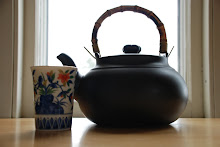Saturday, March 31, 2012
A Reverie
After my morning cup of Keemun, I naturally fell into a reverie about tea. Its deep velvety taste had my thoughts meandering over the many cups I have drunk -both alone, and when shared with others.
I thought of the time, several years ago, when I was in Hanoi with my mom and aunt. The three of us had gathered around a small table, with a cousin, who the two of us -my mom and me- were meeting for the first time. We were in the middle of Lake Hoan Kiem, in an airy pavillion, with hordes of tourists around us. But as we sat there on low wooden benches, sharing tea and stories of our disparate lives, we were oblivious to the tumult of voices around us. Our cousin, a groundskeeper for the small island on the lake, had remained in Hanoi, whereas the three of us had joined the diaspora overseas -so that the trajectory of his life was much different from ours.
He talked to us in such a naturally intimate way about himself that I felt an emotional connection -one that transcended the familial- to a cousin that I had just met.
I do not remember what kind of tea I had nor the kind of cup it was served in, just that my cup was always replenished attentively to the brim, as the four of us sat around a small table in the midday heat of Hanoi.
Tuesday, March 27, 2012
Cardinal Revisited
Farther away
this time on an oak
I see you
framed by the slats of a white fence
a leaf left behind last autumn
a splash
in the grass.
Saturday, March 24, 2012
Black Tea Showdown
 |
| from left to right: a Darjeeling, a Nilgiri, and a Ceylon |
Two of the teas featured were gifts from friends (thanks, GR, for the Darjeeling, to S for the Ceylon). The third was a Nilgiri -unsolicited loot I received in the mail from a tea company.
I brewed all three teas at the same temperature (around boiling point) and for the same duration (3 minutes). The resultant colors of the liquors were surprisingly distinctive when viewed side by side.
The Darjeeling, a Second Flush (harvested in early summer) called Margaret's Hope, brewed up a rich copper liquor, had a fruity aroma, and a full-bodied taste. I half-wanted to curtail the tea tasting there and then to make some masala chai for us, as drinking Darjeeling tea often had the effect of transporting me to the streets of Mumbai, being offered a pewter cup of chai from a chaiwallah...
Pulling myself from the reverie long enough to proceed onward, I came next to the Nilgiri, a black tea grown in the "Blue Mountains" of southern India. This cup brewed up a russet brown liquor, had a piquant aroma that was difficult to characterize ( tropically fruity?), and flavors that were even more unique. I had never tasted anything like it- the liquor on my palate was an amalgam of stone fruits and tropical flowers (what I would imagine the latter to taste like if I'd ever venture to eat tropical flowers). However, the end result was a tea that was too cloying for my taste.
Next up, a Ceylon tea from the highlands of Dimbula, the most famous of Sri Lanka's tea growing regions. This cup brewed up a red brown liquor, had the aroma very familiar to me from childhood -that emanating from a steaming cup of Lipton tea- which was not surprising as Sir Thomas Lipton, an entrepreneurial Scotsman, profited handsomely from Ceylon teas in the early part of the 1900s. The flavors of the tea were bracing and pleasantly astringent -much more satisfying than those from the bagged Lipton tea of my childhood.
Happily invigorated from the tea tasting, I vowed not to wait for another foggy day before having a showdown of teas.
 |
| afterglow |
Tuesday, March 20, 2012
A Shift
I came back to write
and saw
that the light had shifted:
beads of light
and a single strand of hair.
With them went
a thought of a moment.
Sunday, March 18, 2012
Making Matcha
Wordlessly the day
falls into place
when each breath slackens
to the cadence of whisked tea
and errant powder
clings to a wall of light.
Tuesday, March 13, 2012
After School
From the vantage
of a forty fifth year,
through passing glances
at mothers with swaddled babies,
pressed tartans of the after school crowd,
I see my walk
homeward in another time.
Sunday, March 11, 2012
Returning
Try as I may
to go beyond the sun-flecked fur
to the weight of the world:
famine, injustice,
the gaze of conscience
I return yet
to your slow blink.
Tuesday, March 6, 2012
Early March
I am back in the sun room, sitting before an open window, enacting -perhaps prematurely- a rite of spring. The snow of the weekend has ceded to sun-tempered breezes, drawing us to a nook not as frequented during the cold months.
But here we are, sun-dappled, our senses alive to the outdoors. The low lying evergreen, just below the window, does its tremulous dance from last spring -although I know it has danced unabated in my absence.
It is as if we had never left. The cats are in their warm-weather roost, I am in my chair, steeped in the familiar -colored with the present.
Monday, March 5, 2012
Snow-Covered Trees
The streets are slicked with snow
and charged with the light from streetlamps
while in sheaths of moon silver
the two-faced princes carry their weight.
Subscribe to:
Comments (Atom)











